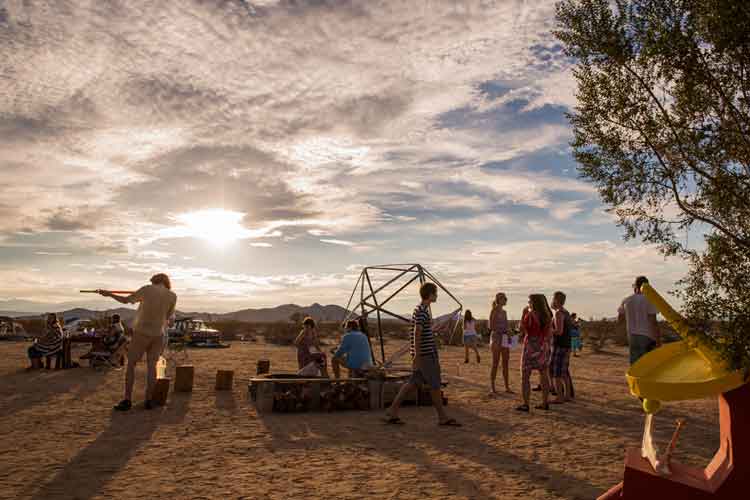Like its Himalayan literary counterpart, Joshua Tree’s Shangrila is a utopian vision; part dream, part tourist destination. Concretely, it’s a one-bedroom residence on Shangrila Lane, overlooking a seemingly endless expanse of undeveloped, government-owned desert. It’s remote enough to seem completely isolated, yet close enough to civilization that you can feel the earthquake-like blasts from simulated bombing raids at the U.S. military fake Iraqi training village in neighboring Twentynine Palms. Originally a homesteader cabin built in 1947, the Shangrila lot was decrepit when artist and curator Drew Dunlap purchased it in 2005 while enrolled in Otis College’s MFA program. In addition to envisioning his future home as a vacation rental, Dunlap also wanted to establish a sporadic artists’ residency where one could create works inspired by epic surroundings. Today Shangrila resembles a mid-century modernist spec house with a swing set and three conspicuous shipping containers in the back yard.
In 2008 Dunlap executed his plan, inviting a few dozen artists for a weekend of experimentation and imaginative planning. They planted the seeds for what would become “Shangrila”: the art event, which debuted in June of 2010. For this first weekend event, Dunlap curated art and performances investigating questions of utopia. I participated in this show as an artist, and again the next year (which, in the spirit of full disclosure, probably dulls my critical edge a little). While there were many fine works on display in that 2010 show, Rob Faucette’s intervention stood out as particularly poignant. Faucette invented Girlfriend Beer, a fictional company that “sponsored” the event. The artist stuck DIY labels on cheap beer cans, posted roadside ads, and distributed free branded koozies to visitors. I couldn’t help but take his work as a preemptive inoculation by satire against corporate sponsorship.
As the perennial art happening matured, Dunlap shifted his role, co-curating “Shangrila: New Moon” with artist Michelle Chong in June of 2010. During the day, Veronica Duarte’s iconographic self-guided tour relayed meandering information about Joshua Tree and its history, while at night Taylor Tschider’s galaxy in a cardboard box beautifully echoed the Milky Way above. In early fall of 2011, Dunlap turned the event over to the collective Durden and Ray, who put on “Shangrila: Oasis.” I missed out on this iteration, but stories of naked BBQ cooks, stalagmite campaign signs by Elizabeth Gahan, and Brian Thomas Jones’ glowing super-phallic inflatable tube confirm that I should have been there.
Unlike other desert art events like tech-yuppie Burning Man, or the more elite High Desert Test Sites, Shangrila remains emphatically emergent and wonderfully unpredictable. Somewhere in between the blazing Friday sunshine and the hungover Sunday drive home (after a transcendental visit to the Integratron sound bath a few miles away), Shangrila morphs from nervous art opening into a temporary autonomous zone where people transform in strange ways. I’ve witnessed buttoned-up academics get shit-faced and near-naked with people navigating in and around in-situ artworks pursuing nocturnal trysts.
This year, the curatorial team of Steven Bankhead and Jesse Benson organized “Shangrila: Burrito Deluxe,” which included 50-plus artists. To manage the expansive undertaking, they enlisted other curators. As Bankhead notes, “Jesse and I both distinguish ourselves more as organizers… We weren’t so interested in curating specific types of art but rather organizing a group of artists that are doing interesting things.” On Friday, Calvin Phelps hosted “Supper,” a performance/gourmet meal inspired by the desert. The collective Elephant created an impressive temporary stage resembling their LA outdoor space. And with the help of Michelle Chong, Elephant scheduled a series of performances throughout the night, many of them by members of the LA sound art organization, SASSAS.
One of the greatest things about Shangrila is the ability to encounter work in the surprising desert landscape. As Benson puts it, “While some works were immediately recognizable in the environment, others were more difficult to ‘discover.’ Stumbling through the desert at night with a flashlight and encountering a work is of course different than seeing a work in a gallery.”
This experience is a welcome invitation to create site-specific installations, exemplified this year by Fatima Hoang’s small inflatable sun, which kept rising and falling throughout the night, commenting on the promise of new beginnings while comically punctuating Joshua Tree’s picturesque vista.
Like any event incorporating lots of artists with multiple agendas, Shangrila always has hits and misses. While some works fall flat in their new desert context—especially those that cling to the safety of the property’s shipping containers, which mimic the white cube—others remain indelibly memorable because they reimagine our relation to the desert landscape. In the end it’s the strange weekend-long event that creates the critically important space for contemplation.


